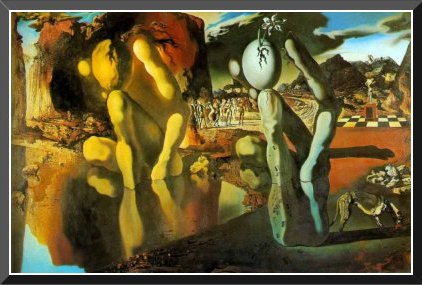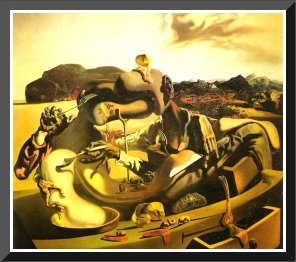

![]()

I must have been nine years old when I first saw the print of the painting "metamorphosis of Narcissus" by Salvador Dali. I will never forget that first encounter. It was mesmerising. I had never seen anything quite like it; the realism of this surreal scene was bewitching. From that moment I knew that the image of this painting would stay with me for the rest of my life.
The years passed and I studied other works by Salvador Dali, and realised that his paintings penetrate the very fabric of the subconscious and like the scalpel of a master surgeon, expose "the three constants of life: the sexual instinct, the sentiment of death, and the anguish of space-time." (Salvador Dali in "Dali", Harry N. Abrams. INC. New York, 1968)

Metamorphosis of Narcissus (1937)
(Completed in 1937, this painting now hangs in the Tate Gallery, London, and is perhaps one of, if not the greatest work by Salvador Dali.
It is based around the theme of the Greek mythological character Narcissus, a youth who fell in love with his own reflection in a pool of water.
This painting, as with all of Dali's paintings, can be analysed and interpreted on many levels. In the foreground on the left is the kneeling figure of Narcissus. His beautiful and youthful face, the cause of his affliction is hidden from view, it is not important. Emerging from the pool of water, which should be a symbol of life, he appears lifeless.
On the right of Narcissus, again in the foreground, a decaying hand, in shape both like stone and bone, holds an egg. All the limbs of the body of Narcissus are reflected in the form of the fingers of this hand. From a crack in the egg a narcissus flower has emerged, which lacks radiance, and is a poor example of its kind. Ants, one of Nature's aids in decomposition and decay are quickly climbing the hand, coming closer to the narcissus flower, which in life appears to be a representation of death. Has the hand metamorphosed into Narcissus, or vice versa? Life a reflection of death, death a reflection of life; it does not matter, since either scenario is just as powerful and meaningful.
To the right of the hand, a dog savagely tears into the flesh of what was once alive and perhaps beautiful.
In the distance and positioned exactly in the centre of Narcissus and the hand, are a group of preening figures who oblivious to all around them, pose in the reflective water narcissistically.
To the right of the hand in the distance again there is a figure totally self-absorbed standing on a pedestal, placed in the middle of a floor, patterned like a chessboard. On this pedestal Engrossed in one self, but for how long? The game of life and death waits below and there is no escape.
The essence of what Dali conveys so masterfully, is that beauty, and life itself are transient. All that lives, no matter what its quality, is destined to perish.)
***

Autumn Cannibalism (1936)
There is an ethereal quality in Dali's works, which many surrealists have endeavored to achieve without success. His technique of photographic realism, and the particular cinematic style he adopted, involves the spectator too closely for his own comfort. Each painting is like a vivid and living dream or hallucination. Once seen it is not easily forgotten. The effect is not always pleasant, and it is not meant to be so. Dali opens a door to a different level of consciousness, where we can not only see but also feel the effects of war, death, famine, religion, and the general struggle of life at every level in the twentieth century.
It is not surprising that an artist with such a genius for probing the human psyche was eccentric. Indeed through out his life he did many things, which would categorise him as a madman. He had even questioned his own sanity saying; "The only difference between me and a madman is that I am not mad." Yet, as William Hazlitt said a century earlier in "Thoughts On Taste" (1818); "Rules and models destroy genius and art." The important factor, which raises Dali above many other artists, is that in his art as well as his life, he was faithful to his obsessions, holding nothing back, and thus, the whole man is present in every painting.
Every artist's, indeed every person's psyche is a product of life's experiences, and it is important to know something of Daliís life in order to understand his art better.
Salvador Felipe Jacinto Dali i Domenech was born on May 11th 1904 in the small agricultural town of Figueres, Spain. He was the son of a prosperous notary. His older brother died nine months before he was born. Because his birth and his brother's death were so close together, his parents treated him as a reincarnation of his older brother. This was obviously the first shift in his personality, and the cause of his disturbing obsessions with decaying corpses.
His imagination started its intense journey when he was about eight years old. He used to spend hours in a large cement basin filled with water, in an old laundry room, which was later turned into a studio for him. He would sit there absorbed in his own thoughts, and thus the first seeds of his genius were planted.
Soon after, Dali's parents sent him to stay with their friends, the Pitchots, who were a cultured family with a taste for art and music. Ramon Pitchot was a Paris based Impressionist and his richly coloured paintings adorned the Pitchots' dining room. This made a deep impression on Dali. He had now found painting, the instrument through which he would record his subconscious thoughts and impressions for the evaluation of the physical eye in the third dimension.
Having already worked as an impressionist, and then a cubist, he found his true self in surrealism, and joined the Paris Surrealist Group in 1929. However, he soon realised that his vision was different to those around him, and quickly tired of the group, once saying; "The difference between the Surrealists and me is that I am a Surrealist."
In 1929, he also encountered Gala, the woman who later became his wife, muse, business manager, and inspiration. After Galaís death in 1982, Dali's health deteriorated rapidly and on January 23rd 1989, he died from heart failure and respiratory complications.
Dali should be remembered and celebrated as a genius who was and is unique in his own field; fearless and honest in exposing what lies within the psyche. With his brush he captured images which take the spectator to new realms of possibility.
Katy Kianush
August 1998
Copyright shall at all times remain vested in the Author. No part of the work shall be used, reproduced, stored in a retrieval system, or transmitted in any form or by any means electronic, mechanical, photocopying, recording or otherwise, without the Author's express written consent.
Copyright © 2004 K. Kianush, Art Arena